November 28th – Day 9
 |
| We may be south of the Arctic circle, but it's still Baltic out! |
I was getting myself ready for breakfast when the announcement was made that we’d crossed the Arctic Circle southbound at 0904h local. The weather had gotten rougher overnight, something that had been foreshadowed by our dramatic approach to Stamsund the previous evening. Things were calmer as we approached the first port of the day, the small community of Nesna. This was one of those “blink-and-you’ll-miss-it” ports, primarily aimed at serving local communities. Unusually for these small ports, there was no cargo waiting to be picked up, although a number of locals boarded. This turned our visit into a rather quick affair, and we were back on our way five minutes after tying up alongside. Given the poor weather, I spent most of our journey to our next port of Sandnessjøen in Ten Forward, the observation lounge up on Deck 9. With snow and hail showers moving through seemingly every couple of minutes, I was not in the mood to take any chances with the weather. Eventually though, we made our way down the inside passages to Sandnessjøen, our next port and gateway to one of the most spectacular sections of the coastal route, when the weather allows.
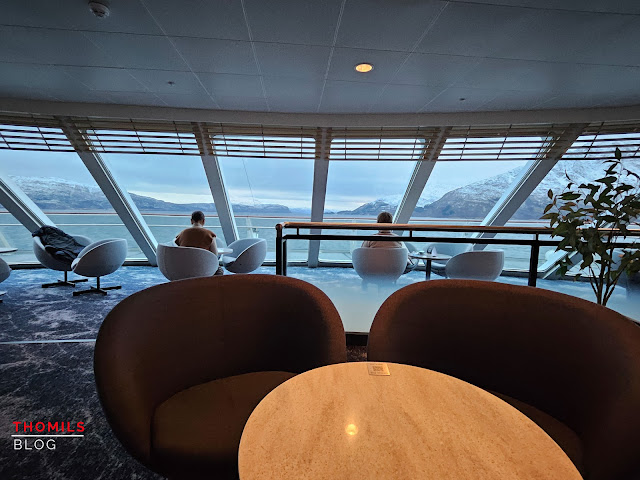
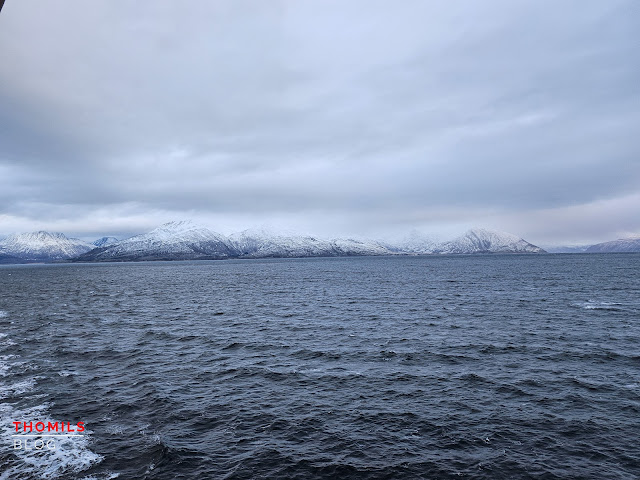

 |
| Approaching the quay in Nesna. It's another one of these quintessential small ports on the coastal route. |
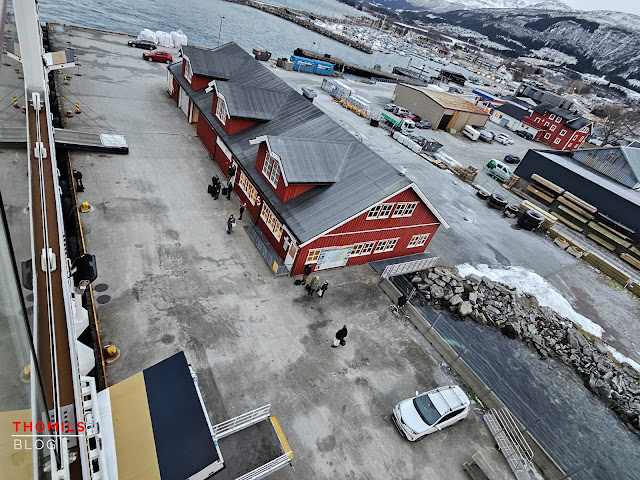 |
| No tourists here, only a handful of locals waiting for the ship like you'd do for a bus or train, |
One of the side effects of our southbound journey was that the cities were getting bigger, with Sansnessjøen being a prime example. The coastal route terminal backed right up against a large hotel and swimming pool complex, and the town had a distinct urban character that had been missing from the likes of Hammerfest, Sortland or Svolvær. The offshore industry was making its presence felt as well, with a number of offshore service vessels dotted around the port. Also, is it just me, or did the local port authority swipe one of the quayside buildings at the terminal from the local airport? Seriously, that thing looks like a control tower!
 |
| The farther south we get, the more signs of civilisation appear along the shore. |
 |
| Local ship traffic also picks up, such as with this car ferry. |
 |
| Fair play to those outside on deck, they're made of stronger stuff than I am! |
 |
| While that bridge looked impressive, we didn't pass under it. You could say that left us in suspension... |
 |
| Approaching the quay in Sandnessjøen, our first bigger port of the day. |
 |
| Am I going even more crazy than normal or does that building on the right look like someone swiped it at the local airport? |
 |
| The terminal building in Sandnessjøen is significantly more extensive than many others on the route. Meanwhile the Seven Sisters mountain range is hiding itself in clouds in the background, apparently suffering from an acute case of self-consciousness... |


Misappropriated building or not, we were still running behind schedule as we came alongside and tied up. So our port call was once again cut to the shortest possible time, helped by the fact that we only had two or three pallets to unload. A family with small children was waiting to board at the terminal, and we were soon back on our way. Unfortunately, the weather was genuinely miserable, which was a shame. I mentioned a little earlier that Sandnessjøen is the gateway to one of the most spectacular sections of the coastal route. That’s because the town sits at the foot of the Seven Sisters, a chain of seven nearly identical mountain peaks that tower over the surrounding landscape. This is generally one of the highlights of the southbound coastal journey, and so the expedition team had arranged for a little event on Deck 8 to showcase the landscape and explain a bit of the mythology surrounding the Seven Sisters. Unfortunately, it appears that the sisters were dealing with an acute bout of self-consciousness, hiding behind low-lying clouds, and both the wind and regular showers turned the event into a rather refreshing affair. Indeed, shortly after leaving Sandnessjøen, Havila Castor got slapped by a mother of a hail shower, and even the expedition team, all Norwegians who are well accustomed to the vagaries of the weather here, beat a quick retreat back inside. Never mind whether I liked the weather or not, it was clear that, on this day at least, the weather didn't like us!
 |
| Talk about a fast-moving shower. That thing would eventually catch up with us even though we were moving away from it! |
 |
That's a pretty good representation of the day's weather...
|


Back inside as we made our way to our next port, Brønnøysund, I opted to enjoy the trip from Ten Forward, the Deck 9 Observation lounge. Even though the sun was still setting depressingly early, the ever more southerly position of our ship was being reflected by the landscape, with many of the low-lying locations and islands being effectively clear of snow. I never thought I’d appreciate the browns and greys of late autumn as much as I did on that day. Then fact that I watched these landscapes pass by through the massive panoramic windows of our ship definitely helped though. And then there was the calm, the tranquility. I’d noticed this several times before, but an air of calm, seemed to infuse every corner of the ship. Sure, you’d hear some low conversation, but beyond that, or the occasional whirring of the coffee machines in the lounge, the ship just felt peaceful, tranquil, cozy. Next to me, the young family that had boarded in Sandnessjøen was looking after their infant kid. Further down the lounge, another group was quietly playing cards, whilst others were reading or, in the case of one blogger, trying to take notes on the experience. Unfortunately, one group of cruise passengers did their best to spoil the quiet, talking with a volume and sense of self-entitlement that only served to, once again, remind me why I’d emigrated to Ireland.
 |
| On the approach to Brønnøysund. |
 |
| I don't know why, but I love this view of a local neighbourhood that just happens to have a large coastal ferry pass by twice a day. The street lights reflected on the wet roads, the warm lights inside the houses, it all just seems so reassuringly mundane... |
 |
| The lights of Brønnøysund beckon in the increasing gloom of the sub-arctic dusk. |
 |
| The building in the back is home to the Brønnøysund register, whilst the one in the foreground is a branch of the local district court, at least on top. |
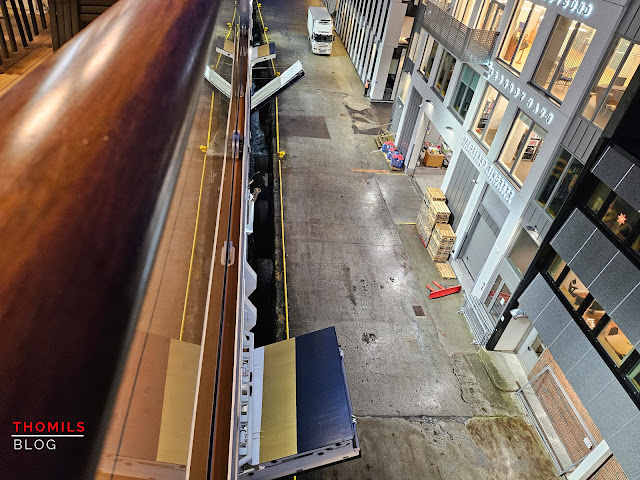 |
| The bottom part houses the warehouse & distribution centre that handles cargo for ships on the coastal route, |
 |
| The terminal itself is of a far older vintage though. |
By the time we reached Brønnøysund, the sun was setting, hours later than It had happened just a few days earlier at the North Cape, but still too early for my taste. The approach in the fading light of dusk was still something to behold, with the lights of the town blazing ever more brightly in the increasing darkness. As Havila Castor made its way through the skerries and islets separating the port from the surrounding fjords, I couldn’t help but be amazed by just how normal the sea was in this part of the world. Houses of all sizes sat mere meters away from the coast, all decked out in Christmas lights, warm light streaming from windows looking out equally over the coast and a nearby car park and playground built right onto the seashore. For the families here, having a coastal ferry float by outside their living room window was just a fixture of life, an everyday occurrence. Our berth in Brønnøysund was equally mundane, butted up right next to a hypermodern office building that reminded me of my former workplace in Cork. That office building turned out to be the home of the Brønnøysund Registry, the central state registry for all types of commercial endeavours, from sole traders to multinationals like Statoil and all financial records pertaining to them. In most other countries, such a crucial facility would have been sequestered away in a secure location, but here, it was located right on the edge of a fjord and a busy pier. Equally pragmatic, part of the coastal route terminal had been built over by a modern annex housing the local branch of Helgeland district court, which was sitting right over the same warehouse that coastal route cargo was being stored in.
 |
| More Star Trek than anything else. The bridge of Havila Castor is about as modern as you can get. |
 |
| Given the amount of automation in the ship, it makes sense to have sizeable lounge areas for the crew. |
 |
| The engineering station is equally futuristic. |
However, my highlight of this stay was located right on the ship itself. The day before, the expedition team had announced that there would be a limited capacity tour of the bridge of the ship. Do I have to spell out that there was a me-shaped hole in the conference room wall as soon as that was announced? Yep, I signed up as soon as the daily meet-up had concluded. There was no way in hell I was going to miss out on this! And what a bridge it was. Now, between harbour tugs, research vessels, patrol boats, mine hunters and full-on guided missile frigates, I’d seen quite a few ships’ command decks before, but nothing on the scale of Havila Castor. This ship was computer-controlled and it showed. Gone were the ship’s wheel, analogue instruments and even my old favourite, the chart table! Instead, the entire command deck was dominated by large multi-function displays that could display every ship’s function and system at a heartbeat, with keyboards everywhere. The only control input devices were a number of sticks to manually control the engine pods when entering or leaving port. In fact, outside of that, or sensitive areas such as Trollfjord, the ship was generally running on autopilot, with the bridge crew only there to monitor the systems and intervene in case something went wrong. This was reflected in the crew numbers, with usually no more than two or three officers on watch on the bridge, although there were of course engineers on duty in the engine control room as well. With that level of automation, the presence of comfortable lounge chairs on the bridge made a lot more sense, those things had stumped me when I’d originally walked onto the bridge. And needless to say, the view through the panoramic bridge windows was just spectacular. This wasn’t your granddad’s bridge, and I’d have loved to know what my dad would have made of the entire setup.
 |
| Can someone call an exterminator? I think we have an invasive species aboard! ;) |
 |
| The reception area of Havrand restaurant on Deck 6 hasn't been spared either! |
 |
| Fried Brussels Sprouts with a jalapeno mayo. Much better than the overcooked mush I remember from my childhood (sorry, dad!) |
 |
| Another sailor-free sailor's steak! |
 |
| Chocolate, coffee *and* crème brûlée? Yes please, where do I sign up? |
Darkness had long since fallen by the time we left Brønnøysund and it seemed that the weather was getting worse as well. And onboard, things were changing as well. The calming tranquility was still there, but from Deck 4 upwards, it was clear that an invasive species was taking over the ship. Everywhere you looked, Christmas trees began to spring up, whilst outside the head waiter’s desk at the Havrand restaurant, a model of Tromsø’s Arctic Ocean Cathedral had materialised. Elves were beginning to pop up as well, though they seemed to stay clear of the shelves from what I could see. The upcoming holidays were definitely beginning to make themselves felt. And whilst an atmosphere of calm still permeated every angle of Havila Castor, every nautical mile that passed under our keel brought us closer to the end of this magnificent voyage. It was with these conflicted thought in my mind that I made my way to Havrand for what would be the final dinner in that restaurant. Not feeling in the mood for experiments, I opted for a starter of fried Brussels sprouts with jalapeño mayo and local Bufar cheese, yet another sailor’s steak and a chocolate and coffee crème brûlée. The steak was perfectly cooked this time around and I was genuinely happy to find a recipe for Brussels sprouts that veered away from the overcooked variety I’d gotten to know as a kid.
 |
| It's strange to have ports that are familiar to you because you already passed through. But that's the case here in Rørvik. |
 |
| There's not much in the way of cargo waiting for us, though, |
We reached Rørvik, the final port of the day, shortly after dinner, still running behind schedule. The approach was pretty choppy, and the waters would only get more so as we left the harbour after picking up the handful of passengers and two pallets of cargo that had been waiting for us on the quayside. We were about to embark of the longest section of the coastal route, not calling into another port until Trondheim the next morning, and the choppy seas meant that this overnight passage would be interesting, to say the least. Not wanting to take any chances, I popped a seasickness tablet and turned in for the night.
November 29th – Day 10
That seasickness tablet had turned out to be the right decision. The overnight passage had been rough and whilst I once again didn’t get seasick, I certainly didn’t get a good night’s sleep either due to the ship’s constant pitching and rolling. Having to time turning around in bed to the movements of the ship was, shall we say, an experience! I did get some sleep though and woke up early on the last full day onboard just as we tied up alongside in Trondheim. We were still running about an hour late, the ongoing rough seas making it tough to make up any delays by simply running faster and so, our turnaround in Trondheim was once again very quick.
 |
| Hello, Munkholmen. Long time, no see. |
 |
| The only other Havila Kystruten ship I saw throughout the entire trip, waiting for us clear our berth in Trondheim! |
 |
| The last time I had this view, it was in dazzling sunshine. |
By the time I’d finished breakfast, Havila Castor had slipped its moorings and was just beginning to leave the port. It was strange to notice just how familiar the area around Trondheim had become to me, even though I’d only been here once before. As Munkholmen passed to our port side, a northbound coastal route ship came into view, just waiting for the berth we’d just vacated. This time around, it was one of our Havila sister ships, probably Havila Capella, but since my morning coffee hadn’t kicked in yet, I’d neglected to make a note of the actual name.
As we made our way south towards Kristiansund, I began to notice a marked shift in the atmosphere aboard. On one hand, the ever present tranquility that I had grown so fond of was still there. And the ship was still very much a coastal ferry, with a significant number of locals onboard. But there was a very noticeable edge to things now, a sense of impending departure. In fact, I’d found a cruise card statement wedged behind the outside door handle of my cabin that morning, which also contained the technicalities of disembarkation in Bergen the next day.
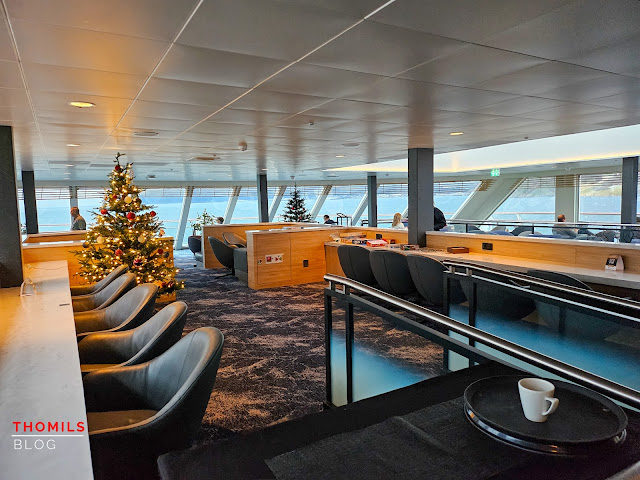 |
| The holidays are making their presence felt in the observation lounge. |
 |
| Snow has pretty much bowed out at this point, at least at sea level. The only white thing in sight is this coastal lighthouse. |
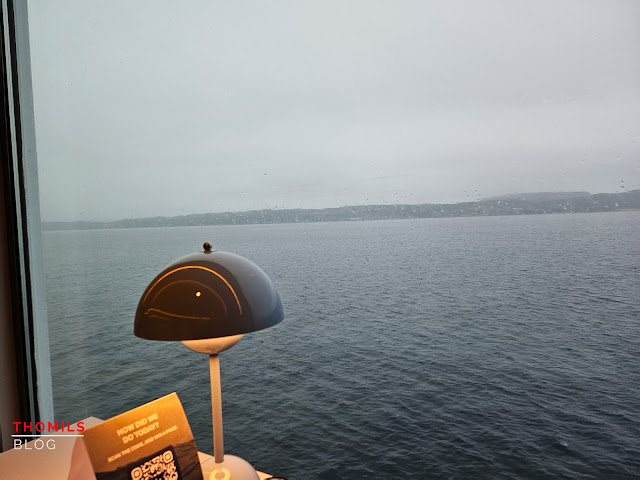 |
| We might still be in Norway, but the weather is turning distinctly Irish. |
That was something for tomorrow though. We still had a few ports to get through before then. The big port of the day was Kristiansund, a city we had passed through in the middle of the night on our way up a little over a week ago. We had a ways to go until then though, with Havila Castor only scheduled to arrive in the afternoon. In the meantime, I once again got comfortable in the lounge. The weather had shifted noticeably overnight, and we were now steaming straight into a storm system that had battered Ireland just a few days earlier. As a result, the sky was grey and overcast, and the air had warmed up considerably. As a result, even the snow was leaving, with many of the skerries we passed completely devoid of the white stuff.
The stretch to Kristiansund was another long one, and we were still on our way there when I decided to pop into Havly, the onboard café, for lunch. I’d booked a table in Hildring, the ship’s fine dining restaurant, for the evening and just wanted something down to Earth for lunch, opting once again for a burger. By pure coincidence, I found myself sitting next to a Kristiansund local who’d boarded the ship in Rørvik the previous night and was using Havila Castor to return home from a business trip. I can only imagine the conniption fit that some of my former colleagues would have gotten if someone in my former company had had the gall to submit an invoice for a cabin berth for reimbursement! Too bad we hadn’t really moved into the Nordics by the time I left that company, I’d have loved to see that!
 |
| Local traffic is picking up considerably. |
 |
| One of the many, many lighthouses on the route. |
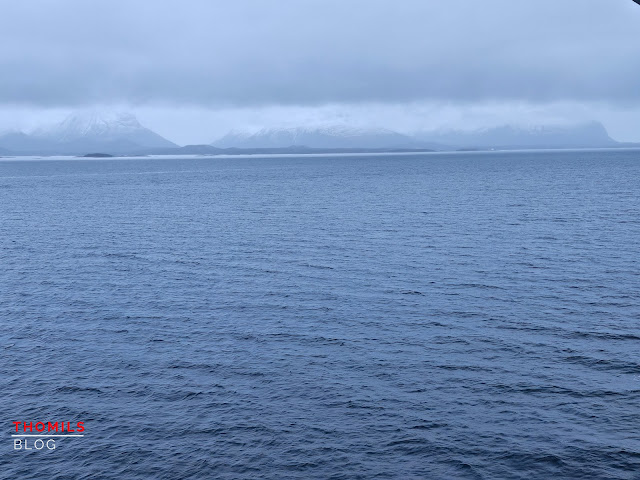 |
| I'm kind of bummed out by the weather. We should be passing along one of the most scenic parts of the Norwegian coast right now. |
Other signs of the upcoming end of our journey were also in evidence. The onboard shop on Deck 6, which had seen a steady but slow trickle of customers throughout the journey, was suddenly besieged by cruise passengers looking for mementos of the incredible journey they’d embarked on, including yours truly. By contrast, the daily briefing in the conference room, a fixture of shipboard life since we’d left Bergen ten days ago, was noticeably bare, with only a few ports and no major events scheduled before our arrival into Bergen in the early afternoon of the next day. In fact, most of the meeting was taken up by going through the ins and outs of disembarkation and any airport transfers.
 |
| In cod we trust. Bacalao may not look like much, but it was actually pretty tasty! |
The sun had long since set and we were deep into the blue hour by the time Havila Castor reached Kristiansund, the city that Cod built. I’m not even joking about that. Built on four islands, the surrounding rich waters had made excellent fishing grounds for centuries, whilst the many bare rock skerries and cliffs that clustered around the main islands had made it easy to dry the previously salted cod. The resulting klippfisk, salted and dried cod, had a shelf life measured in years and had consequently turned into the main export for Kristiansund and the surrounding regions, regularly being shipped as far south as Portugal and even Brazil. In fact, as one of the last onboard events of this journey, the expedition team had arranged for a tasting of bacalao, a Portuguese cod stew that was actually quite tasty. I was just glad that they’d spared us the taste of the pure klippfisk.
 |
| Making our way into Kristiansund. |
 |
| Having your city centre on one island isn't that had. Having it on four islands? Now that's an achievement! |
 |
| Offshore service vessels, such as this survey ship, are becoming more and more common as we move south. |



We left Kristiansund after another abbreviated stop, heading inexorably south. I spent much of the time after leaving Kristiansund in my cabin, packing up all my belongings in preparation for disembarkation the next day. With that out of the way, I had one more highlight ahead of me, dinner at Hildring. Located on Deck 6, this is the fine dining option on all Havila coastal ferries and is subject to an extra charge for cruise passengers. It also operates with a rotating five course set menu, instead of a la carte, as Havrand does. It is also a far smaller and more intimate venue than the main restaurant, making the experience much more personal. A quick read of the menu for the last evening onboard made for enticing reading, whilst the fact that we’d be passing through the Hustadvika, a known rough spot along the Norwegian coast, at the same time made it questionable just how much I’d be able to enjoy it.
 |
| A special treat for the last evening aboard: Dinner at Hildring Fine Dining! |
 |
| The shape of things to come! |
 |
| The evening's menu! |
 |
| We're starting off with King Crab from Varanger (the region around Kirkenes) with arctic ponzu. Where's the rest of that crab? |
 |
| Scallop served in its own shell served with a horseradish vinaigrette, herb sprouts and caviar. |
 |
| Pan-fried turbot with a butter sauce, caviar and a crispy crudité of thin fennel slices. |
 |
| Rack of lamb from Dovrefjell (central Norway) with caramelised carrot puree and borettane onions - The only "land based" dish on the menu. |
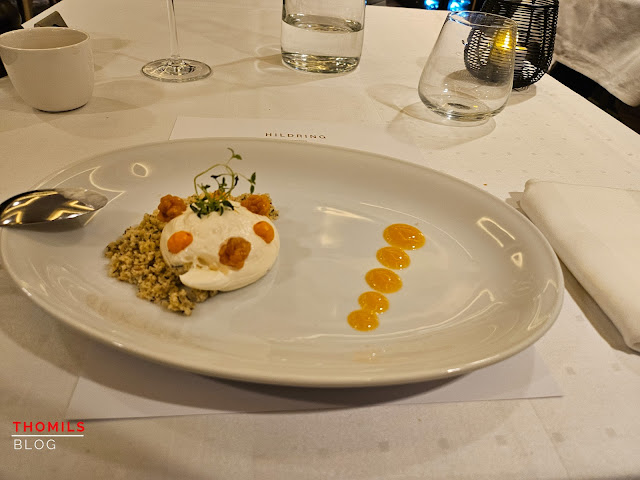 |
| Sea buckthorn cream with cloudberries and herb crumble for dessert. |
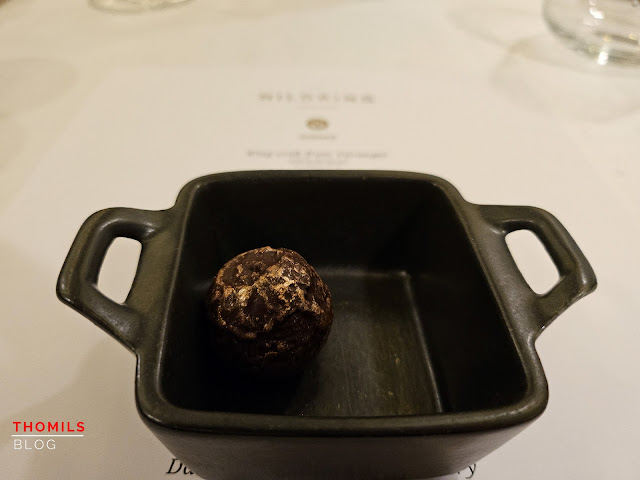 |
| Dark chocolate confectionery to round out an absolutely exquisite meal! |
I needn’t have worried about that. Whilst Havila Polaris definitely had to battle against the waves, and the motion of the ship was pretty strong, even with its stabilisers deployed, the staff were absolutely amazing, whilst the atmosphere in the small restaurant was relaxed and familial. They even got me to enjoy wine, something that rarely happens, in fact I’d go out of my way to track down a bottle of that Sauvignon Blanc one back in Ireland.By the time the last course of this truly exquisite dinner was finished, we were already on our approach to Molde, the last port of the day. As I watched the lights of this small coastal city recede in the distance, the realisation that, less than twenty-four hours later, I’d be back home in my flat in Ireland hit me like a freight train. Slowly but surely, this trip of a lifetime was coming to an end. With this melancholic thought spinning around in my head, I turned in one last time, foregoing a seasickness tablet because I didn’t know how it would mesh with the wine I’d had over dinner.
 |
| Approaching Molde in the mist. |
 |
| There's a shore party waiting for us on the quay as we come alongside. |
 |
| One of the local car ferries has tied up for the evening. |
November 30th – Day 11
Yeah, about that decision not to take a seasickness tablet…
I’d completely forgotten the fact that overnight, we’d be passing through the infamous Stadhavet, an area of ocean so rough that the construction of a ship tunnel to avoid it had been approved. And sure enough, shortly after leaving the port of Ålesund on our way south, things got nasty, with the sea really letting us have it. After a few hours of restless sleep, I finally gave up on getting anymore and, one last time, made myself presentable. Before heading to breakfast, I packed up the remainder of my belongings and dropped off my monster trolley at the reception on Deck 4. I wouldn’t have to worry about that for the rest of the passage, it would be available for collection at the terminal in Bergen after disembarkation. I wasn’t the only one opting for this service, as by the time I dropped off my trolley, a pretty impressive collection of suitcases had built up at the base of the elevators on Deck 4 well before the 0900h drop-off deadline. At the same time, all cruise card accounts had been closed, although it appears that for some reason, my drinks and meal package would still be honoured unlike what had been stated in the handout we’d been issued the previous day.
 |
| Intermodal infrastructure, Norway style: Having your bus station right by the coastal route terminal! |
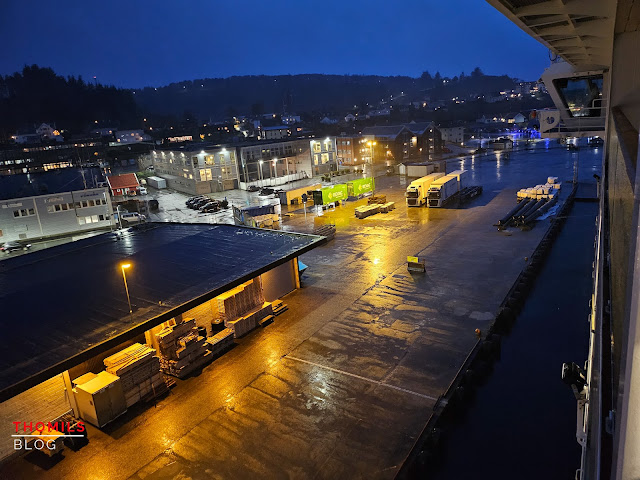 |
| The weather is typically Irish, and will remain so until I arrive in...Ireland. |
 |
| That's a survey ship tied up alongside the bus terminal, if I remember correctly. |
We were alongside in the port of Florø by the time I finished my breakfast. The weather was absolutely rotten, although we’d at least made it into the warm sector of that storm that was moving towards Norway. Still, the ongoing lack of daylight, combined with the low cloud cover and the seemingly incessant rain, made for a glum atmosphere as I made my way into my cabin one last time to grab my jacket, backpack and shopping bag to while away the rest of the journey in one of the lounges. All cabins, with the exception of the suites of course, had to be cleared by 1000h to allow housekeeping to get them ready for the next set of cruise passengers that would board at Bergen.
We were still behind schedule when we left Florø and it soon became clear that, even after the rough spot in the Stadhavet, the sea wasn’t done with us yet. Granted, we were in fjord country now, the region in the South of Norway that contains some of the most impressive fjords in all of Norway, including of course Geirangerfjord or the massive Hardangerfjord, but due to the low cloud cover, we would see precious little of that. And while the coastline was criss-crossed by numerous protected sounds, firths and other protected passages, we would also have to cross the entrances to a number of those fjords, which would make once again for a rocky passage at times. And so, with the weather outside our ship quintessentially Irish, I settled down with all of my stuff to wait. An uncomfortable familiarity came over me. How many times had I waited like this before? Sitting in a place that had become familiar and filled with memories but that was now just an empty husk, just waiting for my time to actually leave and move on? The information screens all over the ship only reinforced this feeling, the daily program listing no activities, no shore excursions and only one sight for the day, as well as the total distance covered by the round trip from Bergen to Kirkenes and back, 4930 kilometres. It was all too familiar.
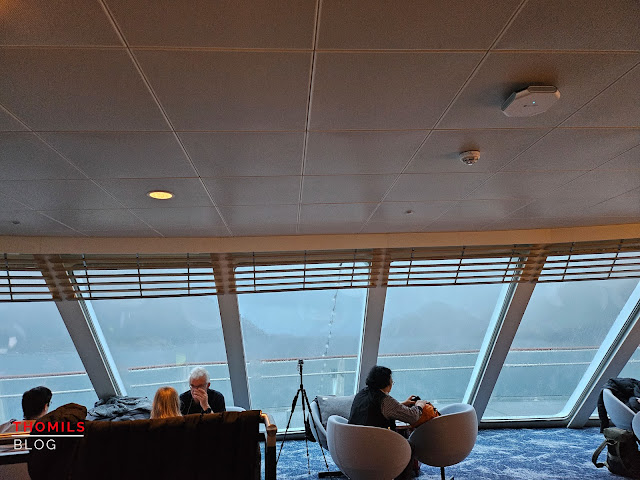 |
| That just about sums up our experience today. Heading through the sounds of Norway effectively on instruments. |
 |
| If those waterfalls look like they're nearly close enough to touch, they are! |
 |
| Car ferries like this are an indispensable bit of infrastructure here. |
It was not all doom and gloom though. We may have been running behind schedule, but it seemed like the bridge crew weren’t going to take this delay lying down! Rather than sailing serenely through the sounds of the Fjord Coast national park, Havila Castor pushed through them at what seemed like flank speed. Sitting up in Ten Forward, it was quite the exhilarating experience to look out through the rain-covered windows of the lounge as we raced through those fjords basically on instruments, relying on radar, GPS, and the officers’ knowledge of the area. Throughout the morning, you could find yourself looking out to port and just casually watch a mountain sail by seemingly within touching distance whilst a look straight ahead would yield the fascinating, if disconcerting, sight of another mountain appearing out of a rain squall only a kilometre or so ahead. Invariably, the ship would turn in time to easily avoid this mountain, only to shortly find itself racing towards another island necessitating a turn in another direction. Meanwhile, you’d be treated to the view of waterfalls racing down a nearby cliff off of our starboard sight as we passed at nearly 30 km/h and less than 100 meters away from us. All the while, the landscape felt more and more alive than it had at any other time on this trip, with farmhouses and small hamlets dotting the coast, interspersed with the inescapable landings for the ferries that tied all of these skerries to each other, and the mainland.
After a while, I noticed that the deck of the observation lounge was beginning to sway. Havila Castor was emerging from the sheltered inside passages into the mouth of the massive Sognefjord, one of the largest fjords in the entire country. Incidentally, this is an area that was always beloved by my late father. All the way back in 1974, he’d taken a ferry from Germany all the way to Norway and driven all over this massive fjord in his trusty Volkswagen Beetle. He always talked fondly of this and following his death in 2017, I found quite a few scanned pictures of this trip on the file server I had saved from my parents' home. I guess there was always a deep love and longing for Scandinavia that ran in my family, and I’m sure my dad, indeed both of my parents, would have loved to come with me on this trip of a lifetime.

Unfortunately, I was rather less thrilled by this encounter with my dad’s past. For starters, there’s still wasn’t much in the way of scenery thanks to the miserable weather. More importantly though, a twist of fate, and geography, meant that the mouth of Sognefjord faced in such a way as to point directly into the direction of the winds and waves of that approaching storm, whilst our course meant that we would have to sail nearly broadside on for much of our crossing of the fjord. Rather than trying to tough it out all the way on Deck 9, my stomach and I decided to head lower into the ship to reduce the effects of the rolling seas. I’d wanted to check in with the excursion team anyways, as I was beginning to get worried about my airport transfer in Bergen. They reassured me that, even with our delay, I’d have plenty of time to make the connection, which reassured me somewhat, but a certain level of worry remained.
 |
| The chefs aboard are excellent and deserve every bit of praise they get. But sometimes, you just want a bit of comfort food! |
Still, there was nothing I could do, I was literally along for the ride. As we entered the protected waters south of the Sognefjord and the motion of the ship began to subside, I decide to finally grab some lunch. However, with my stomach still being unsettled both from my short night and that rough patch we’d just passed, I opted once more for comfort food, going for a pizza and Coke Zero at Havly, instead of a full-on lunch in Havrand. I just had that need for cheese! About an hour later, we finally entered Herdlejord, one of the approaches to the port of Bergen, still moving at what passed for breakneck speed for a coastal ferry. Even though we were firmly in the south of Norway now, the sun still began to set early, and after a few hours of light grey outside, the early evening gloom began to settle over the landscape even as the increasing number of houses on the surrounding islands made it clear that we were passing through Bergen’s commuter belt. An hour later, with the light beginning to fade, we entered the port of Bergen proper, Nordnesparken passing by on our port side as Havila Castor finally began to slow down for her final approach to our berth at Jektevikterminalen, where this whole incredible journey had begun eleven days earlier. The sights around me, the offshore service vessels moored in the port, the buildings surrounding the industrial quays all around us, even the mountains towering around us, it all seemed strangely familiar, although much of the surrounding mountains was shrouded in clouds, including of course Mount Fløyen, which only eleven days earlier had yielded such breathtaking views.

 |
| We're finally on the approaches to Bergen. |
 |
| The impressive mountains surrounding Bergen are hidden in clouds today. Almost feels like I'm back in Bad Aussee. |
 |
| Jekteviksterminalen, where it all started for me eleven days ago. |
 |
| Finally docked alongside, and already expected by a boarding party of cleaners. |
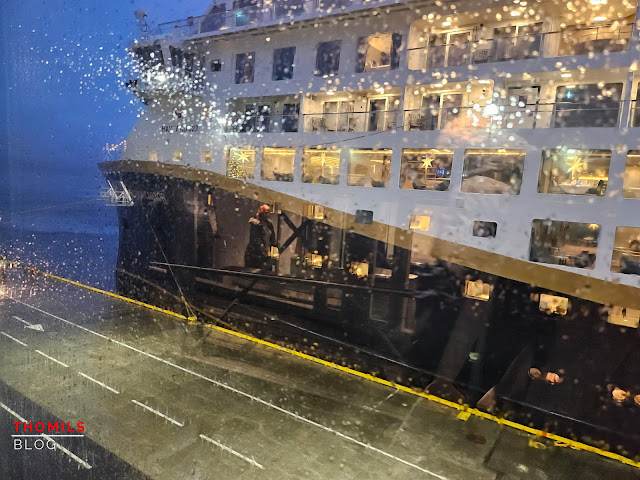 |
| Farewell, Havila Castor, and thank you for the memories You're a good ship! |
It took some work to line our ship up with the terminal in such a way that the gangway at Jekteviksterminalen lined up with Havila Castor’s gangway doors on Deck 5, but by 1545h, we were safely tied up alongside. Before anyone had a chance to disembark, an army of cleaners descended onto the ship, our delay having cut considerably into the turnaround time here at Bergen. Disembarkation soon commenced and by 1600h, it was finally time for me to say goodbye to Havila Castor, the ship that had been my home for the last eleven days, and for the most incredible journey I’d ever taken! That’s not to say that the party was quite over yet. There was still the small matter of a monstrously heavy suitcase. This was delivered on a baggage belt like you see at an airport, and in the case of the Jekteviksterminalen, this was akin to throwing a tuna carcass into a school of hungry sharks. Meanwhile, the check-in counters in the terminal were already under siege by the next load of passengers heading north. After surviving the feeding frenzy, it took a bit more time to find my airport transfer bus. By 1615h, that was sorted as well though. As I watched through the windows of our bus, I could see that the queue of departing passengers in the terminal had begun to move. For them, a journey of a lifetime was about to start, just like it had started for me one and a half weeks earlier. But for the communities along the coastal route, I mused as our bus started on its way to Bergen airport, it was just another day.
 |
| Bergen Airport is impressive, despite its relatively small size. |
 |
| The new terminal was designed from the start for self-service check in, which is a bit of a shame. I've always preferred staffed check-in and bag drop counters. |
 |
| I absolutely love the design though, even though it doesn't extend to the international gates. |
 |
| Fast forward to Amsterdam, where my flight to Cork is waiting. |
It turned out that the expedition team had been bang on with their assessment. We made it to the airport with plenty of time to spare. I’d been impressed by the airport when I’d arrived from Amsterdam, but it was only as the transfer bus pulled up to the kerbside outside the terminal that I really appreciated just what a spectacular facility it really was. It was airy, spacious and yet comfortable. Well, at least the domestic part of the airport was. International flights were handled in the old terminal dating from the 1980s which, whilst clean and efficient, had no airside views at all and generally didn’t lend itself to photography. It didn’t really matter anyway because, after stocking up on some essentials in the duty-free shop, it was soon time to board. My ride to Amsterdam was PH-BXS, a 23-year-old Boeing 737-900 still equipped with KLMs old seats. That didn’t matter though, since I lucked out and the seat next to me remained empty. We pushed back on time and soon took off from Bergen’s runway 17 into the darkness of this early winter’s night. The flight itself was smooth as silk, as was the transfer at Amsterdam which, despite its short transfer window, was long enough for me to stock up on those absolute essentials, stroopwaffel and ontbijtkoek! Boarding for my flight to Cork also started on time, with my ride back home being provided by PH-EZW, a thirteen-year-old Embraer E190. Once again, I lucked out with the seat next to me, which remained empty, and after a short taxi, we took off into the night from Schiphol’s runway 24. Whilst the flight started out just as smooth as the flight from Bergen had been, things got increasingly bumpy as we got closer to Ireland. Following a now familiar pattern, we crossed the course just north of Youghal before turning into an instrument approach to Cork Airport’s runway 16. This turned out to be one of the hairiest landings I’ve had in Cork, with showers and clouds being replaced by clear patches of sky on an almost minute by minute basis, while all the while, our little Embraer was being buffeted by some truly vicious gusts. Touchdown was hard, as could be expected under these conditions but even so, I was in a taxi heading home within fifteen minutes of the aircraft arriving on stand. Without any fanfare, in quite the anticlimactic fashion, this trip of a lifetime had come to an end.
Closing Thoughts
This has been, without a doubt, the journey of a lifetime. I have used many, many words in describing the experience and emotions of traveling along this incredible landscape, and even all of that barely scratches the surface of this magical experience. It is uplifting in its beauty and humbling in its harshness, extraordinary and yet just another aspect of life in Norway. I’ve dreamed of this trip for so long that the moment I sent my foot aboard Havila Castor felt almost surreal. And even though I’ve long considered this trip to be a major item on my bucket list, now that I’ve done it, part of me wants to go right back and do it again. And yet, even though this trip was the culmination of years of dreaming and scheming, I can’t help but note the irony that it finally became reality just as the life I’d built up around me for the last eight years crumbled into dust. And yet, it was worth it!







































































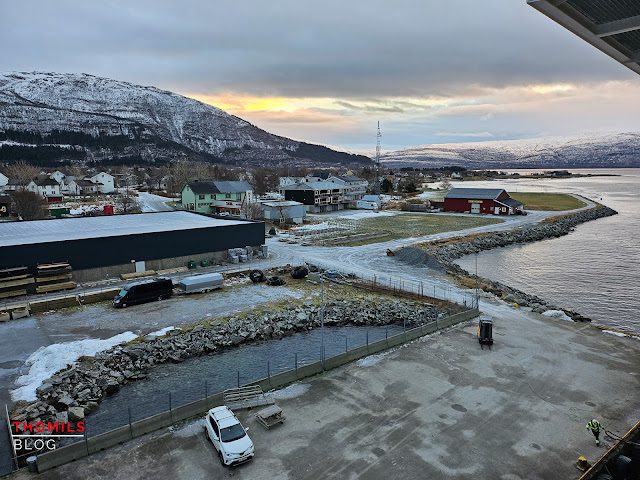

















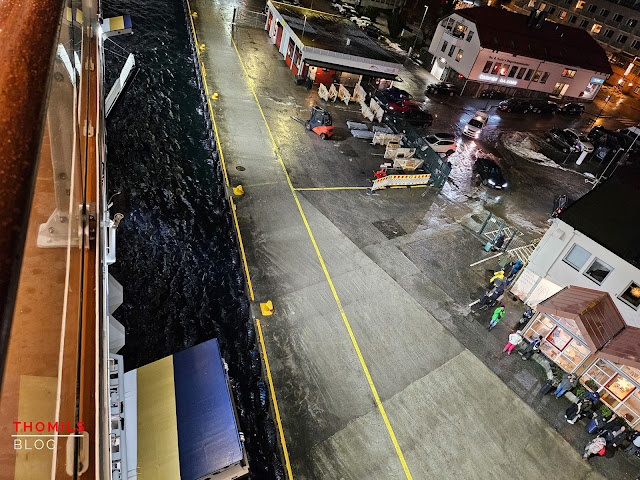


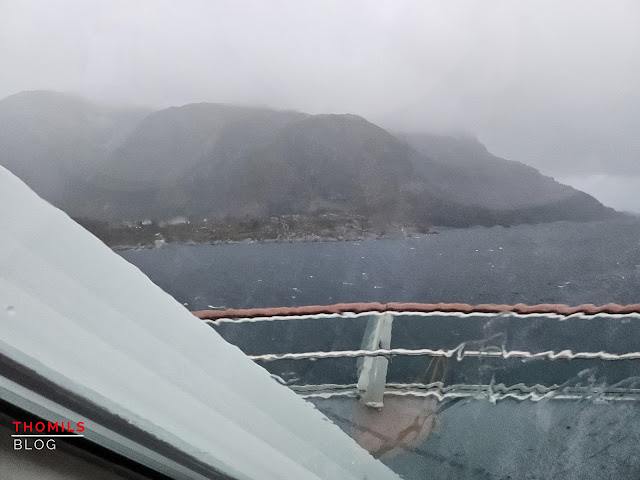












Comments
Post a Comment